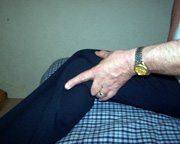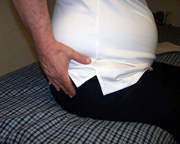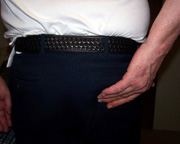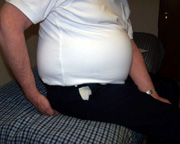 Winning Hands Massage
Winning Hands Massage
Sciatica
First off, there are more ways than one to end up with sciatic nerve pain.
In brief, the main ones are nerve inflammation, impingement or entrapment.
The SOURCE is also variable. It could be from a pinching off of the nerve at
the vertebral foramen where the nerve roots exit the spinal column at L4,
L5, S1, S2 or S3 (vertebral subluxations), from compression caused by a
pelvic tilt or rotation or misalignment of the SI joint which in turn can
cause problems where the nerve passes through the Greater Sciatic Foramen of
the pelvis, or what is known as Piriformis Syndrome. The latter is where the
nerve becomes impinged or entrapped in some configuration involving the
Piriformis muscle.
Effective treatment REQUIRES identifying the root cause. And quite frankly,
most conventional doctors arenít worth a damn in this regard. If you donít
first identify the CAUSE, all you do is end up treating the SYMPTOM. And
until you DO identify and treat the cause, the symptom will just keep coming
back. Seems pretty straight forward, but unfortunately, totally beyond what
seems to be taught in medical schools these days.
For most conventional doctors, the cause is of absolutely no consequence or
concern to their treatment decision. And it isnít because the only treatment
options available to them are symptom driven with no necessary relationship
to actual cause. The treatments available to them are: Bed Rest, Ice, Drugs
(pain killers and muscle relaxants), Gentle Traction, or Surgery.
Even if a vertebral subluxation or pelvic misalignment is involved, you
still need to identify the CAUSE. Is it because of a structural scoliotic
curve or a chronically contracted muscle? And if the cause is a contracted
muscle, which muscle is the guilty party? And so on.
A year ago, I would have been very focused during any treatment work for
sciatica, doing all kinds of tests I know how to do (or at least did at one
time). Today? I donít even screw around with them because it is faster and
easier for me to assess and treat energetically. Specifically, I would start
with the Spinal Snake to take care of any subluxations. I would then assess
and treat for any PSOAS or Piriformis contractions. If necessary, I would
end up with a couple of Craniosacral techniques (a lumbar traction or
decompression at L5-S1 and a bilateral, medial compression of the pelvis at
the ASIS level) to address any lower lumbar/sacral problems. The above
combination would cover any and all of the possible subluxation or
contracted muscle possibilities. The only thing it would not specifically
address would be an actual inflammation of the nerve itself. But since the
underlying cause of nerve inflammation would probably be one of the others
anyway, treat the others and the nerve inflammation would go away.
I use three specific points: back of the knee, side of the glute, back of
the glute (two fingers lateral to sacrum, halfway between iliac spine and
gluteal crease). Hold two points at the same time; knee and one of the
others.
The point
behind the knee is Bladder 54. The point half way between the top of the
iliac spine and the gluteal crease (butt muscle in back in lay terms) is
Bladder 28. The point on the side of the butt muscle is Gall Bladder 30.
Serizawa says to use GB 29 but that is not the one I personally use; I use
30.
Home Page |
Mike's Biography and Training |
Treatment Information |
Mike's Recommendations |
Mike's Writing
(c) 2005-2007 Mike Uggen,
Phone: (317) 297-7263
Cell: (317) 508-8556
WA License Number 16912
Web Design by Barbara Uggen-Davis
 Winning Hands Massage
Winning Hands Massage Winning Hands Massage
Winning Hands Massage


